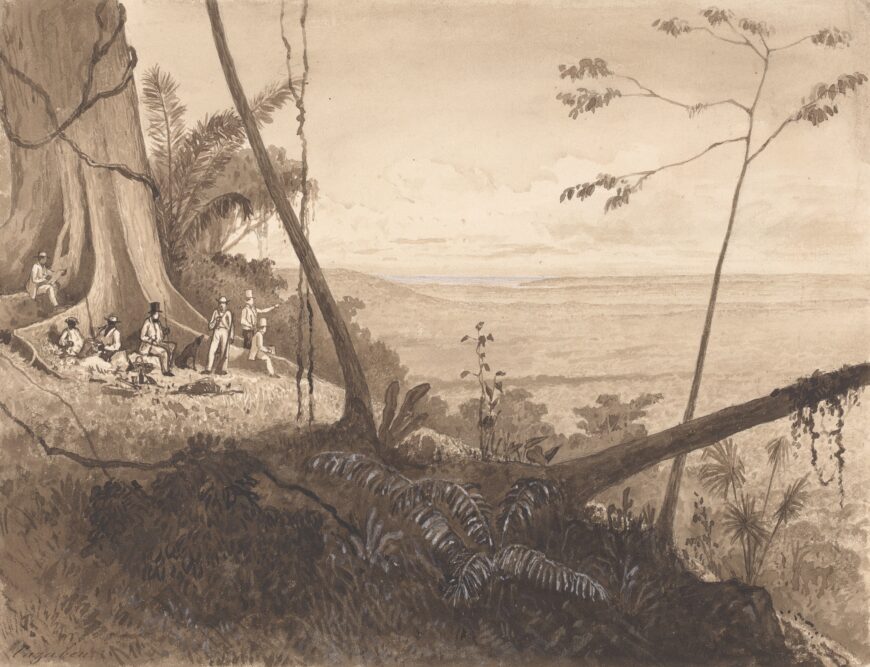
Michel-Jean Cazabon, Cedar Point, Mount Tamana, 1851, pen and brown ink, brown wash, graphite, and white gouache on medium, slightly textured, beige wove paper, 21.6 x 27.9 cm (Yale Center for British Art, Paul Mellon Collection, New Haven)
It’s an almost monochromatic image. This westward view from Mount Tamana in Trinidad is composed of shades of brown ink, masterfully blended to capture a sense of depth with lush, dark vegetation in the foreground and a light rendition of the hazy landscape beyond. White gouache is subtly used to highlight the leaves of a few plants and a sliver of the Atlantic on the horizon. This work is one of many Michel-Jean Cazabon made in the 1850s of the landscapes and resources of this Caribbean island in a variety of media.
The artist and the governor
Cedar Point, Mount Tamana was created for George Francis Robert, the third Lord Harris and the British governor of Trinidad since 1846. After a decade in Europe, Cazabon returned to his native Trinidad in 1848 and opened a studio as a landscape painter and art teacher in the capital of Port of Spain. The art market of this British colony was small, with few professional painters. Nevertheless, Cazabon received commissions from some of the wealthiest and most influential figures in Trinidadian colonial society, quickly attracting the attention of the governor.
Harris became Cazabon’s most important client between 1849 and 1854, when Lord Harris left his post after the death of his wife. The painter created a series of works that allude to the governor’s private and working life, responding to his desire to document what he knew was a temporary stay in the Caribbean.
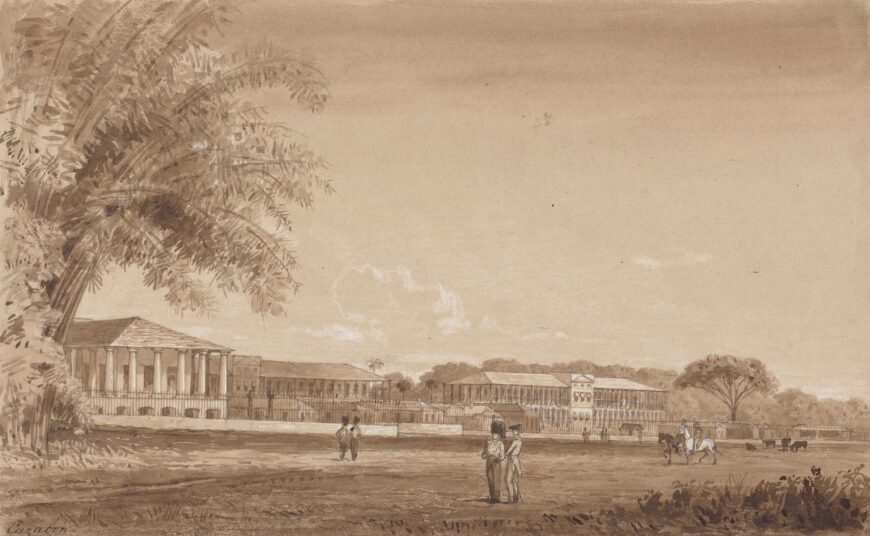
Michel-Jean Cazabon, St. James Barracks, 1851, pen and brown ink, brown wash, graphite, and white gouache on medium, slightly textured, beige wove paper, 19.1 x 30.5 cm (Yale Center for British Art, Paul Mellon Collection, New Haven)
Cazabon created compositions centering on government buildings, the governor’s residences, the St. James Barracks, and both the main Anglican and Catholic churches in Port of Spain. Works like these show an ordered and thriving colony through idealized landscapes, seemingly influenced by the governor’s beneficial administration.
The artist also accompanied Lord Harris on hunting excursions around the colony and documented the sites. Cedar Point, Mount Tamana is the result of one of these trips. He made a version of this composition in oil for the governor and featured a print of it in Views of Trinidad, the first of his three lithographic albums.
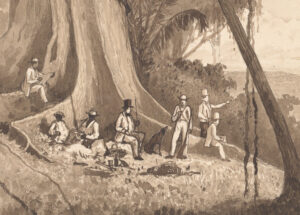
Seven figures (detail), Michel-Jean Cazabon, Cedar Point, Mount Tamana, 1851 (Yale Center for British Art, Paul Mellon Collection, New Haven)
Mount Tamana is in Sangre Grande, a westward region in Trinidad. The composition features a view from Tamana that includes part of the mountain itself on the left side. There, in the middle ground, is a group of seven figures resting at the foot of a great silk-cotton tree. One of the men in top hats, perhaps the one pointing toward the land in the background, may be Lord Harris. [1] The man seated on one of the tree roots on the extreme left, seemingly sketching in the portfolio in his hands, may just be the only known representation of the artist himself. [2] He locates himself near two Black figures sitting on the ground, who are likely the guides for the hunting group. The watercolor could be a preparatory model for the lithographic version and the oil painting, though this last one contains some variations. The composition is largely the same, but Cazabon included an eighth figure to the group and slightly shifted their poses.
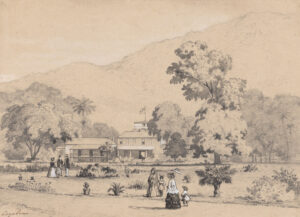
Michel-Jean Cazabon, The Governor’s Residence, St. Anns, 1851, pen and brown ink, brown wash, graphite, and white gouache on medium, slightly textured, beige wove paper, 19.4 x 26.7 cm (Yale Center for British Art, Paul Mellon Collection, New Haven)
Trinidad through the picturesque
Cazabon found his niche amongst the wealthy British landowners and politicians eager to commission art to commemorate their property and work in the Caribbean. His work for Lord Harris falls into this category, and his approach demonstrates an understanding of his clientele’s sensibilities. Cazabon trained as an artist in France, but this production in Trinidad is clearly informed by the British taste for the picturesque, which involved a preference for idealized rural and urban landscapes, where nature acquires an almost manicured quality and buildings seem to blend in harmoniously, like a natural part of the geography. The picturesque was developed in late 18th-century England by William Gilpin and it became popular amongst professional and amateur landscapists after the publication of his 1768 treatise Essay on Prints. In this essay, Gilpin presented the picturesque not as an art style but as an aesthetic that produces beautiful images and aims to capture a sense of the roughness of nature through a compositional formula that includes elements like winding paths and unthreatening country folk. The list of subscribers of Cazabon’s lithographic albums express interest amongst the local elite, like the archbishop, members of the clergy, high-ranking navy officers, and doctors in his vision of a picturesque Trinidad. [3]
This can be appreciated in pieces like St. James Barracks and The Governor’s Residence, St. Anns. Like Cedar Point, Mount Tamana, these were also used as references for compositions in the album of prints Views of Trinidad. Printed in Paris, this album consists of 18 views of Trinidad—many of them based on work done for Lord Harris.
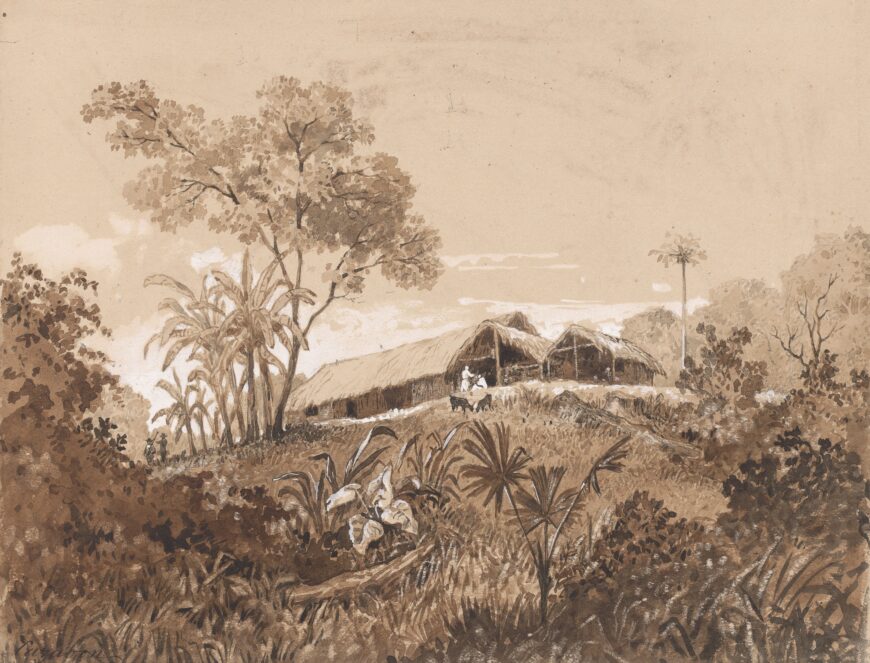
Michel-Jean Cazabon, The Cottage, Mount Tamana, 1851, pen and brown ink, brown wash, graphite, and white gouache with scratching out on medium, slightly textured, beige wove paper, 21.3 x 27.6 cm (Yale Center for British Art, Paul Mellon Collection, New Haven)
Through these images of Trinidad’s nature and sights, a picturesque vision of the island’s tropical beauty was crafted to complement the colony’s efficient institutions. Small human figures are scattered in the scenes, representing the island’s diverse population but responding to the picturesque model by avoiding representations of hard labor or conflict. In Cedar Point, Mount Tamana, the figure who may be Lord Harris surveys the ordered land he governs.
When Lord Harris arrived in Trinidad, he found a colony still dealing with the economic changes produced by emancipation. The abolition of slavery was ratified in 1834 and the apprenticeship period ended in 1838, during which, full liberty was granted to all the remaining enslaved people. By the late 1840s, the sugar industry was going through its worst moments, still affected by a labor shortage. Many of the formerly enslaved left the sugar plantations once the apprenticeship ended and were not interested in returning as paid workers.
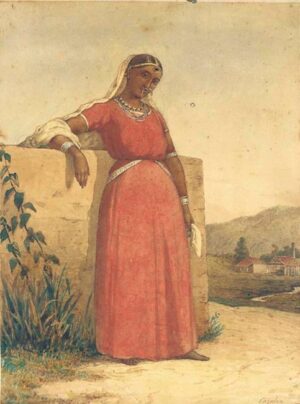
Michel-Jean Cazabon, Mookta, Female Labourer, on the Garden Estate property of Alex Gray Esquire, Trinidad, watercolor on paper, 29.2 x 22 cm (private collection)
Race and Cazabon’s images
Under Lord Harris’ administration, Indian indentureship voyages were organized to supplement the workforce with cheap labor. The Indian indentureship system was established after full emancipation as a way to bring cheap labor from British India to maintain the plantation economy. Indian laborers signed a three to five year contract to work in the English Caribbean. An immigrant protection office was created to assist those arriving to work in Trinidad. In addition, the British government helped to finance the endeavor. Yet the traveling conditions were harrowing for the Indian immigrants, and life as indentured workers in Trinidad was akin to slavery. Lord Harris eliminated the exportation tax on local products and sought to reduce the cost of imported goods. He was also interested in administrative and educational reforms. He promoted the opening of schools, the building of roads, and the establishment of secular education oriented to serve a diverse society, not only to try and accommodate Indian and Chinese immigrants, but to ease tension amongst the Catholic and Anglican populations. All this helped stabilize the local economy and made Lord Harris a popular governor.
Trinidad’s historic context was far more complex and tense than what we see in Cazabon’s images. Cazabon surely understood these tensions well, as he was a Black man born to a mixed family of African and French ancestry that moved to the island when it was a Spanish colony. His landscapes, while presenting tranquil scenes ordered by colonial rule, include the island’s diverse population. Small Black figures share the same public spaces and scenery, but often separated with clear distinctions of class. Black figures tend to be represented as working class or surrounded by allusions to work. These details emphasize for whom the album Views of Trinidad was intended, though the artist does not shy away from prominently representing Black figures in his compositions.
Unfortunately, very little personal information from Cazabon has survived. As a result, we don’t know how he navigated these tensions while working for a mainly white British clientele. In Cedar Point, Mount Tamana, Cazabon features himself working and far away from the white members of the group. While he was a more socially privileged figure than many of his Black subjects, and his work allowed him to move among the upper echelons of colonial society, here he sets himself apart from his clients. He sits by the Black guides, firmly stating his belonging and role among this group. This compositional detail acts as a small window to Cazabon’s life, how he experienced Trinidad, and how he saw himself within it, even through a picturesque lens.
Notes:
[1] Amar Wahab, Colonial Inventions: Landscape, Power and Representation in Nineteenth century Trinidad (Newcastle upon Tyne: Cambridge Scholars Publishing, 2010), p. 129.
[2] Geoffrey MacLean, Cazabon: The Harris Collection (Port of Spain: MacLean Publishing Limited, 1999), p. 21.
[3] Tamara Díaz Calcaño, “Michel-Jean Cazabon y Francisco Oller: pintura y sociedad en el Caribe decimonónico” (Ph.D. dissertation, Complutense University of Madrid, 2019), p. 216.
Additional resources
This work at the Yale Center for British Art
Selwyn Cudjoe, Beyond Boundaries: The Intellectual Tradition of Trinidad and Tobago in the Nineteenth Century (Wellesley: Calaloux Publications, 2003).
Tamara Díaz Calcaño, “Michel-Jean Cazabon y Francisco Oller: pintura y sociedad en el Caribe decimonónico” (Ph.D. dissertation, Complutense University of Madrid, 2019).
Geoffrey MacLean, Michel-Jean Cazabon: An Illustrated Biography of Trinidad’s Nineteenth Century Painter (Port of Spain: Aquarela Galleries, 1986).
Geoffrey MacLean, Cazabon: The Harris Collection (Port of Spain: MacLean Publishing Limited, 1999).
Amar Wahab, Colonial Inventions: Landscape, Power and Representation in Nineteenth-Century Trinidad (Newcastle upon Tyne: Cambridge Scholars Publishing, 2010).

